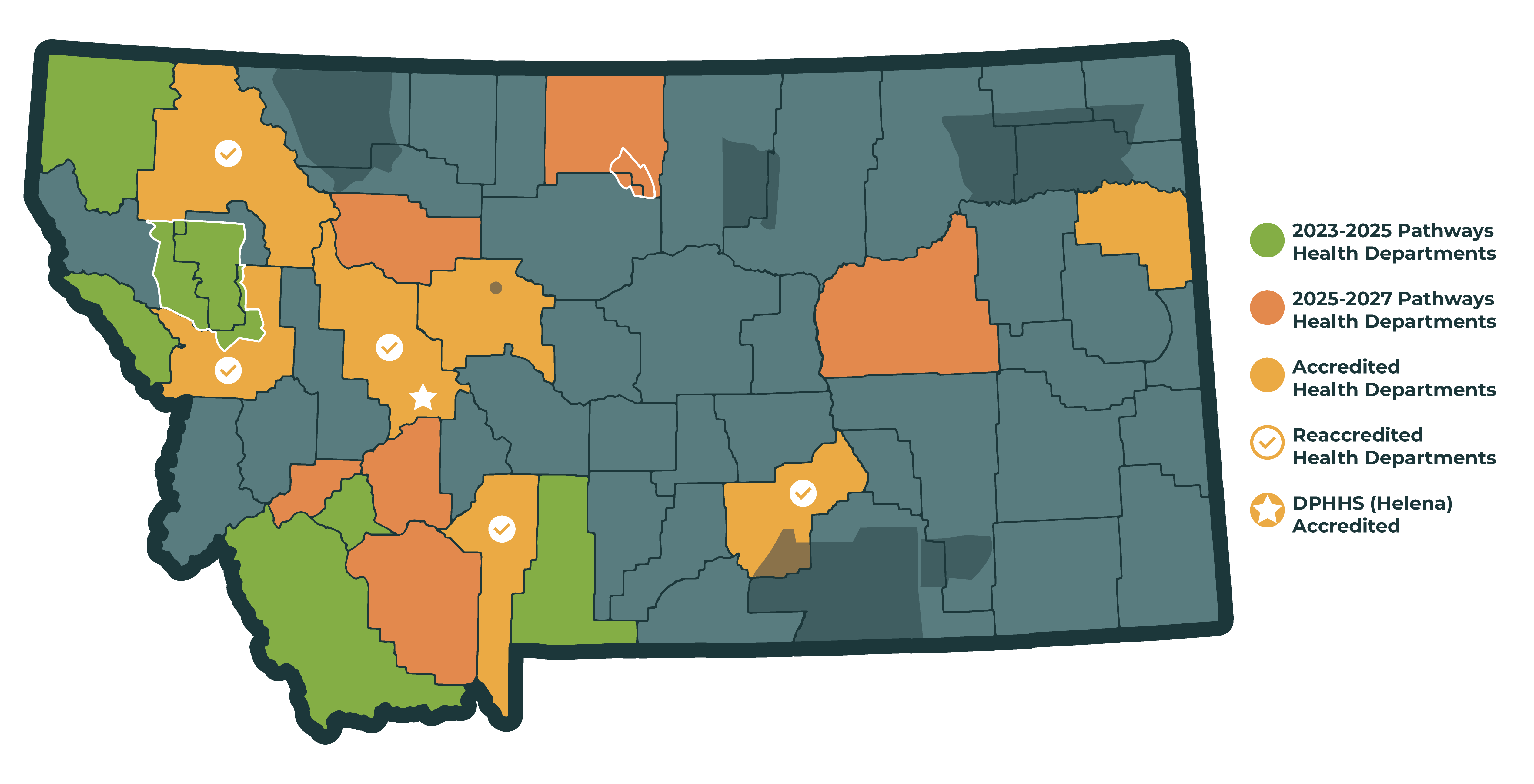Welcome to Performance Excellence
Accreditation and Pathways to Recognition through Performance Improvement
Accreditation and recognition provide a means for health departments to build capacity in key public health areas. The Public Health Accreditation Board (PHAB) offers two programs for health departments to be recognized for meeting national public health standards.
Accreditation and Pathways Recognition support performance improvement efforts and can be part of a health department’s transformation journey. Each is built on evidence-based standards that allow health departments to demonstrate performance and accountability to communities, policymakers, and other stakeholders. The System Improvement Office can help interested jurisdictions determine which program is right for them.
Montana has eight accredited health departments and twelve jurisdictions that have participated in the Pathways to Recognition cohort.

Initial
Accreditation means excellence. It means that a health department is committed to continuous quality and performance improvement. Accreditation is a way to engage all staff in transformation and improvement efforts. Initial Accreditation - Public Health Accreditation Board
Reaccreditation
To maintain accreditation status, the health department will be evaluated against a set of national standards 5-years after accreditation status has been awarded. Reaccreditation ensures that accredited health departments continue to evolve, improve, and advance their public health practice to serve their community.
The Standards & Measures document serves as the official standards, measures, required documentation, and guidance blueprint for PHAB national public health department reaccreditation. The Policy presents the process for maintaining accreditation status. Reaccreditation - Public Health Accreditation Board
Fees
PHAB instituted a fee structure to manage and maintain the national accreditation process. Applicant fees are necessary for PHAB to provide quality services to both applicants for accreditation and accredited health departments. Public health department accreditation is not a “one-time” event; it is an ongoing commitment to continuous quality improvement.
PHAB has listened to feedback from health departments and public health partners and adjusted our internal processes and fees to respond to the needs of the field with the new Version 2022 Fee Structure.
Montana Accreditation Network
If you are interested in joining the Montana Accreditation Network, please contact richard.knecht@mt.gov.
Pathways
Pathways Recognition is a program designed to support performance improvement efforts, strengthen infrastructure, and facilitate public health system transformation for local, Tribal, and territorial public health departments not yet ready for accreditation. Pathways can facilitate accreditation readiness for eligible health departments intending to use the program as a step toward accreditation.
Pathways Recognition assesses health departments on the Foundational Capability measures in the PHAB initial accreditation Version 2022 Standards and Measures. There are 34 measures assessed in the Pathways Recognition program, and they are divided into two tracks –Services and Partnerships and Health Department Systems. Pathways Recognition Program - Public Health Accreditation Board
Why Pathways Recognition?
The Pathways Recognition process is a meaningful step along a health department’s performance improvement journey. It allows a health department to make sizable progress toward accreditation by demonstrating achievement of the Foundational Capabilities. Pathways Recognition can also provide a glidepath for initial accreditation by allowing assessment of Pathways measures to carryforward to initial accreditation and through a discount on accreditation fees.
Local and Tribal Jurisdiction Resources
- PDSA Storyboard PPTX
- PDSA Storyboard Template
- PDSA Storyboard Tip Sheet
- PDSA Worksheet
- Project Charter QI Template
- AIM Statement Template
- How to Construct a Fishbone Diagram
- Fishbone Diagram Template
- Affinity Diagram Example
- Just-Did-IT Template
- The 5 Whys
- Communication Template






